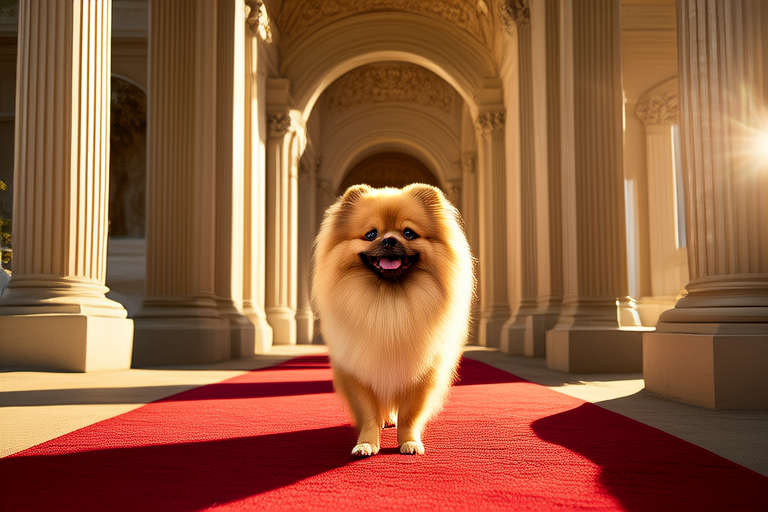The Evolution of Pomeranians: From Royal Pets to Internet Sensations
Pomeranians, with their small size and big personalities, have captivated hearts for centuries. Originally bred as working dogs in the region of Pomerania (now part of Germany and Poland), they have undergone significant transformations to become the cherished companions we know today. This article explores the historical evolution of Pomeranians, from their origins as favored pets of European nobility to their current status as beloved companions and internet sensations.
Origins and Early History
The history of Pomeranians traces back to ancient times when larger versions of the breed were used for herding sheep and guarding property. These early Pomeranians weighed between 30 and 50 pounds, quite different from the toy-sized dogs we see today. Over time, selective breeding reduced their size, and by the 18th century, they had become popular among European royalty.
One of the most notable owners was Queen Charlotte of Mecklenburg-Strelitz, wife of King George III of England. She introduced the breed to Britain in 1767, bringing five Pomeranians with her. Her affection for these dogs helped establish their reputation as fashionable pets among British aristocracy.
Later, Queen Victoria further popularized the breed during her reign (1837–1901). She owned several Pomeranians, including a particularly famous one named Marco, which she acquired while visiting Italy in 1888. Queen Victoria’s love for Pomeranians led to increased demand for the breed across Europe, contributing to their growing popularity.
Changes in Breeding and Popularity
The late 19th and early 20th centuries saw significant changes in Pomeranian breeding. Breeders focused on reducing the dogs’ size even further while enhancing their appearance through careful selection. The American Kennel Club officially recognized the Pomeranian breed in 1888, marking an important milestone in its development.
During World War II, many dog breeds experienced declines in numbers due to food shortages and other challenges. However, Pomeranians managed to maintain their presence thanks to their small size and adaptability. After the war, there was a resurgence in interest in smaller companion animals, leading to renewed enthusiasm for Pomeranians.
In recent decades, Pomeranians have continued to grow in popularity. Their compact size, playful nature, and loyalty make them ideal apartment dwellers and family pets. Additionally, advancements in veterinary care have improved their health and longevity, making them more attractive options for potential owners.
Social Media and Online Platforms
The rise of social media and online platforms has played a crucial role in elevating Pomeranians to internet stardom. These platforms provide a global stage where people can share photos, videos, and stories about their pets, creating communities around specific breeds or themes.
Instagram, TikTok, YouTube, and other social networks offer endless opportunities for Pomeranian owners to showcase their pets’ unique qualities. Many influencers and celebrities have adopted Pomeranians, further boosting their visibility. For example, Paris Hilton, known for her love of small dogs, often features her Pomeranians in her posts.
Moreover, the accessibility of high-quality cameras and editing software allows users to create engaging content that highlights Pomeranians’ distinctive traits. Whether it’s cute poses, funny antics, or heartwarming moments, these videos and images resonate with audiences worldwide.
Unique Characteristics of Pomeranians
Pomeranians possess several attributes that contribute to their appeal as both pets and viral content creators:
- Size: Their miniature stature makes them easy to carry around and manage, perfect for urban living.
- Coat: With a thick, luxurious double coat that comes in various colors, Pomeranians look elegant yet approachable.
- Personality: Known for being intelligent, curious, and energetic, they are always ready for adventure or playtime.
- Loyalty: Pomeranians form strong bonds with their owners, providing comfort and companionship.
- Expressiveness: Their facial expressions and body language are incredibly expressive, making them natural entertainers.
These characteristics combine to create a breed that is both visually striking and emotionally engaging, qualities that translate well into digital formats.
Impact on Modern Perceptions
The increasing presence of Pomeranians on social media has influenced public perception of the breed positively. Many people now view them as adorable, fun-loving creatures rather than just small dogs. This shift reflects broader cultural trends toward valuing companionship and emotional support from pets.
However, there are also concerns about the impact of social media on breeding practices. Some critics argue that excessive focus on appearance may lead to prioritizing looks over health, potentially exacerbating existing issues within certain lines of Pomeranians. Responsible breeding remains essential to ensure the long-term well-being of the breed.
Furthermore, the prominence of Pomeranians online contributes to their integration into popular culture. They appear in advertisements, movies, TV shows, and even video games, reinforcing their image as trendy and desirable pets.
Conclusion
From their origins as working dogs in Pomerania to their current status as internet sensations, Pomeranians have undergone remarkable transformations throughout history. Their journey from royal pets to beloved companions reflects changing societal values regarding animal companionship and entertainment.
The unique combination of physical traits and personality makes Pomeranians stand out among other breeds. As social media continues to shape modern perceptions of pets, it will be interesting to see how this dynamic influences future trends in pet ownership and breeding practices.
